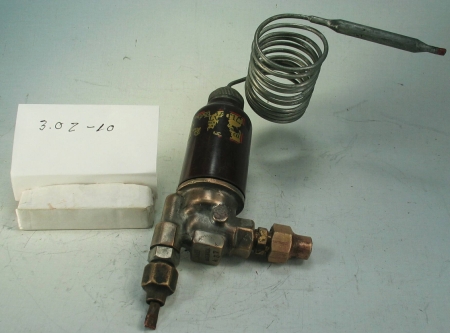Refrigerant Flow Controls – Commercial
An early, small body, adjustable thermostatic expansion fitted with 4-foot remote bulb power element, with brown Bakelite shell and brass body, with stylish, partially obliterated, decal in red and gold, manufacturer yet to be determined based on existing body markings, circa 1936.
Technical Significance:
The valve would stand as a wonderful icon of the early years in TX valve development, as the industry searched for an alternative to the costly and often troublesome, liquid refrigerant, float valve technology of the mid 1920, and 30’s.
This artifact of history tells the many stories of early adoption of this particular refrigerant flow control technology. After a brief flurry of excitement over the use of costly and delicate float operated devices, as a more efficient means of flow control, industry engineers would return to the automatic expansion valve in the early 30’s. But for many medium and larger applications the automatic expansion valve would give way to the more elegant and efficient thermostatic valve for use in a new generation of “dry evaporator” applications.
Industrial Significance:
This valve was more than likely the work of another relative new comer in the refrigeration field in the mid 1930’s. Similar in configuration to the Fedder’s valves of the period, it genealogy remains to be determined from partially obliterated body markings.


